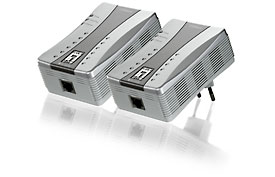HomePlug, on the Internet for ... wiring?

Not so long ago on Habré wrote about the technology Power over Ethernet . There is also the opposite phenomenon - the unification of computers in a local network through ordinary electrical wiring. This technology is called HomePlug
Thanks to it, you can combine computers into a high-speed local network using an existing electrical network without laying additional cables. All that is required for this is special adapters for each device connected in this way.
Explained on the fingers, HomePlug is an electrical wiring technology that operates as follows — a router connected to the Internet connects to other computers via a regular electrical network using special modules. A typical module looks like a large power supply unit with an Ethernet socket and indicators, and is connected to a computer with a regular network cable, the same way computers in a local network connect to each other.

So, at one end of the apartment there is a router, and at the other end, using an Ethernet cable, a computer, laptop or any network device is connected via a PowerLine module inserted into a 220-V socket. For devices that receive the Internet and access to local network resources in this way, it looks absolutely transparent - it doesn’t make any difference to them whether you inserted the Ethernet cable directly into the router or whether you used the PowerLine module. There is a good way out when an apartment has already been renovated, but there is no Ethernet in it and is not planned for the foreseeable future.
')
Of the features worth noting:
- data transfer rate up to 200 Mbps
- - network protection: AES with 128-bit key
- transmission distance - up to 300 meters
- Quality of Service (QoS) management
- Maximum number of HomePlug AV network clients: 64 Powerline adapters
UPD:
Brief description of the principle of operation
The principle of operation of PLC-systems (PowerLine Communication) is based on the separation using filters of low-frequency electrical signals and high-speed data traffic transmitted at higher frequencies (1.6-30 MHz). It is based on the data transmission method, in which the source stream is divided into packets and each of them is transmitted in the 4.3-20.9 MHz frequency range.
High efficiency of the HomePlug in a difficult noise environment is ensured by the redistribution of the power of the emitted signal in the working band. To this end, the device implemented three procedures:
- adaptation to the real jamming environment by eliminating certain operating frequencies affected by interference;
- quick change of modulation method;
- reduce the data rate to improve noise immunity
Adaptation to the jamming environment is carried out without data loss. For example, if one of the 84 operating frequencies is affected by interference, it is simply turned off, but the data packet transmitted on the affected frequency is not lost, but is automatically restored during subsequent processing of information in the receiver.
At the physical level, the transmission of packets occurs in such a way that each package is transmitted only after evaluating the state of the communication channel and the receipt from the receiver of a signal indicating its readiness.
Source: https://habr.com/ru/post/46344/
All Articles